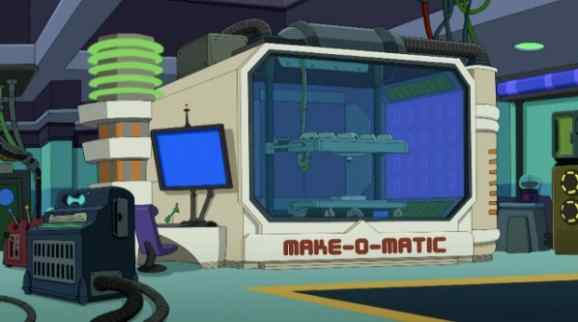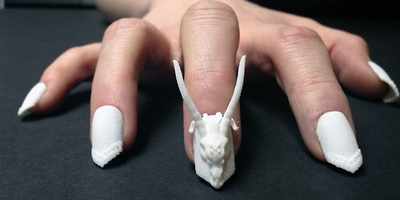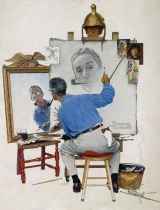3D Printing: The Future of Art and Design

3D printing seems to be one of the newest, most unbelievable technological advances the world has seen in a while. A 3D printer gives its users the ability to create anything in their wildest dreams. You create whatever you want or need on a three-dimensional designing computer program. Then, when hooked up to a printer, all you have to do is click print and, within an array of hours depending on your project, your creation is ready for pickup. The products can be printed in a variety of materials—plastics, rubbers, and metals included—making the possibilities endless. Building a cabinet and ran out of screws? Well, instead of going to the hardware store, you can print them from your home. Want to make a three-foot hyper realistic sculpture of a canary? All you have to do is design it and press print. Although 3D printers are still too pricey to be bought for personal use unless you’re the Wolf of Wall Street, everyone is trying to get their hands on the technology behind these 3D printing microwave machines. The printers are getting used by doctors to make surgical equipment, construction workers for tools, architects to print accurate models of future building plans and, get this; they’ve even been used by NASA to print tools in rockets while travelling through outer space. And, above all, you know something is pretty awesome if it gets mentioned on Futurama (“Forty Percent Leadbelly”).
Although the first prototype for a 3D printer is reported to be made in 1982 by Japanese technician Hideo Kodama, the first working 3D printer was made two years later by Charles Hull who patented the product in the United States. Hull worked at the Massachusetts Institute of Technology and the university worked with his creation throughout the 80’s and 90’s to perfect its abilities. The printer did not gain popularity, however, due to its price tag; the printers were too expensive to manufacture and ship. Years later, MIT allowed certain companies to start mass producing the printers in 2010, which dropped the assembly prices tremendously and allowed the printers to sell more easily. Today, printers vary with quality at a multitude of prices ranging from $3,200 to $800,000. They are surging in popularity today and are quickly being bought by individuals, universities, and industries wanting to take advantage of its freelance design opportunities and endless potential.

The technology is drastically re-imagining every industry it touches. Recently, it has hit is the art and fashion world, its potential and adaptability inspiring many. Artists are printing statues instead of traditionally sculpting them; Jewelry designers are creating their works digitally rather than by hand. 3D printing is flipping the traditional way of doing things on its head, allowing artists more options and designers a limitless landscape for their creations. One of the newest innovators are The Laser Girls, two NYU students who decided to take advantage of their university’s high-end industrial printers. As studio art students working with 3D printing and having a large interest in fashion, The Laser Girls decided to mix these dimensions and enter a realm never seen before in the 3D art world; they began designing and creating 3D printed wearable nails. Being printed in metals and plastics, their nails are aesthetic, wearable pieces that embody glamour and artistic flair. They are pieces of art but are also functional and show expertise in 3D printing technology and engineering, mixing different disciplines together to create an over the top, colorful manicure.

The Laser Girls are just one example of artists who are taking advantage of 3D printing technology. At themost recent Victoria’s Secret Fashion Show, 3D printed pieces rocked the runway. All the models were equipped with intricate 3D printed wings, putting a twist on the signature look of the famous angels. There was even an angel sporting 3D printed lingerie. Printed in a malleable nylon, the model walked in a snowflake inspired lace design that did not rip, tear, or fall apart while being maneuvered in. Does this mean that soon our clothes will be 3D printed? 3D printing has strongly hit the fashion accessory scene; maybe it will become the core of the fashion industry in the future. There are multiple designers such as Miguel Vogel, Bryan Oknyansky and Marieka Ratsma who are already using the printers to make high-end, super theatrical footwear. Even Nike is jumping on their bandwagon as they begin prototyping and creating 3D printed running shoes and cleats in fantastic colors and styles.

It is obvious that 3D printing is adding a dimension to the art world that was unpredictable before the technology was created. But being able to design and print digitally also skews traditional practices of the art world and takes some of its fundamental aspects away. Artists no longer have to harness their skills to sketch the finest detail, sculpt the perfect jaw line of a face, and morph clay with their hands. In a way, printing builds a wall between artists and their creations; it makes the art less about the handiwork and more about the product. It changes the look of the art world—instead of standing in front of a canvas contemplating color and stroke, artists are hunched over computers staring at a three-dimensional grid. Both are creating, but art as a product of the hand and human may become a part of the past. If all art becomes digitally prototyped and created, will art be as genuine? In a world where a piece can be identically duplicated with ease, will there be any more traveling art exhibits displaying lauded “originals”? The long term effects of the printers are still unknown; 3D printing leaves many questions that can only be answered with time. Hopefully the art world will be able to integrate the new technology while keeping the aspects that make it unique as an industry and important to the many cultures of the world.
Still, the amazing technological advancement cannot only be seen in a negative light. For innovators of the 3D printing world, there are no limits. They all seem determined to take this technology and exploit it as much as possible, creating beautiful, functional and fashionable works. Outside the art world, creative innovations are also being produced. It seems that 3D printing is one of the only things that can bring artists, doctors, and businessmen together; they all have a need to produce, a desire to create, a craving to discover. These printers give the hope of an exciting future, allowing people to be successful and lauded for their imagination and creative insight more easily than the traditional artist. As long as the gun industry doesn’t shut down the industry (keep your fingers crossed), it will be an amazing ride to watch 3D printing develop and grow as its creators begin to push the limits of this new innovative technology. And, maybe one day, 3D printing will become as commonplace, speedy and simple as Futurama makes it out to be.
What do you think? Leave a comment.










You should visit the Museum of Art & Design in Columbus Circle, NYC. There is an exhibit on digitally designed objects, including quite a few incredibly impressive printed things. It’s pretty amazing.
The Laser Girl actually had residency and an exhibit there. I’ve been a few times. It’s a really awesome place!
As a marketing manager for traditional manufacturer we are discussing the advent of 3D printing almost every day. My take is additive manufacturing has a place but it is still looking for it.
There are several things you need to make a 3D printed product of anything. A CAD model of the thing you want to make, obviously a 3D printer, the raw material to print the thing you want to make and most importantly – the knowledge to integrate all of the above into a coherent plan.
So, the real question should be about the desire of the consumer to want to make these things, themselves.
For example, a component in your car fails. The first thing you need to do is know which component in your car failed. You would then need to know how to create a 3D CAD model of the component you need and just as importantly, what material is it made of – after all, if the component sits in the engine bay you might not want to make it out of polypropylene. And the printer? Arburg have just released a fridge freezer sized 3D printer that can “print” in ABS (a pretty standard plastic used in most products) – it costs just north £100k excluding costs of the medium – which is a pretty toxic mix of chemicals that can be fused into an ABS product. The machine will inevitably require a maintenance contract and very regular cleaning.
Of course, you can just take your car to the dealer, get them to identify the offending component, pull if out of stock, fit it and charge you £150 for the all-in-service.
In the same way that laser printers disrupted the document production industry and PDFs have disrupted the laser printing industry, you still will cannot get the original raw files used to create these media from the originators – you will not get the CAD files required to 3D print products protected by IP from the likes of Bosch, BMW, Siemens, Nokia. Any 3D printed components will not carry the same guarantees or performance warranties as the original components.
What will be interesting to see however is how the after-market parts supply chain will develop for complex products, 3D printing will take off massively when you can go to a product dealer (fridge/car/television), order the component and they print it for you.
Very informative article. I never knew 3D printers existed until they used one on The Big Bang Theory. Thanks for sharing the info.
It’s a very interesting, fast movin industry. Keep following it! Well never know what it will do next~
You forgot to mention the 3D printers that can replicate themselves or print parts to build a better model of themselves, or the first ever fully 3D printed dress designed for and worn by Ditta von Teese, and in exhibit now at the M.A.D. NY. Or the first 3D printed gun, then made illegal and now the only copy of it in exhibit in a museum in London. Good article though.
The idea of printers that can build copies of themselves is an interesting one considering that one could simply (in a more advanced time) send the printer to an asteroid or planet with the correct minerals present via spaceship and subsequently create an army of printers. Repeating the process would yield planets crafted perfectly to our liking that would be literally waiting for us to visit them.
Imagine the erotic possibilities….
The company I work for designs and manufactures industrial pointing devices for the medical, marine, aerospace markets amongst others. We recently invested in a 3-D printer for producing our own prototype parts, rather than paying for SLA models.
The printer works very well, but the raw materials are still very expensive and the most difficult aspect of producing a part is cleaning it up afterwards, removing the support material and so on … very messy!
Yes I can imagine! My sister works with 3D printers so I hear all the horro stories!
3D Printers are even making artwork obsolete.
Thanks for sharing! I am fascinated by this emerging technology and didn’t honestly know too much about it before your article.
Then I’m glad I wrote it! Thanks so much~
Awesome information about 3D printers. I finally understand the concept and how amazing they really are. Thanks for sharing.
Mary- I’m glad you chose to write an article about 3-D printing. I have to add some insight into it as a professor of art who uses digital technology including 3-d printing.
There are a lot of misconceptions surrounding 3-d printing.
First off, you do need a certain skill in art to make something interesting. The average person cannot walk off the street and create an object of interest. If you can’t draw it or sculpt it you cannot make a 3-d print of it. Yes you can buy templates but that relies on an artists ability as well.
The scientific applications of 3-d printing are the most amazing stories coming out of the new medium. 3-d printed organs, bones and prosthetics are creating a new way of thinking in the medical field that was hindered by current technologies.
The cost of a 3-d printer and it’s materials is going down every year. there are models for hobbyists and professionals and the materials list is expanding to include various plastics(ABS and PLA)and metals.
3-d printing will not replace any art mediums. Digital cameras did not replace film, digital illustration did not replace drawing. the 3-d printer is a tool that artists will use just like any other.
Thank you for reading my article. As a professor who teaches it, I’m honored you took the time to look through this. I understand that a great amount of skill and creativity is needed in 3D printed. My sister is a Laser Girl; the mechanics of 3D printing and artistic insight are dinner conversation. There so much that goes into creating something digitally, which is why the industry is so amazing and growing so quickly. The prices for printers are going down, especially for MakerBots, but the prices for hardcore, industrial printers are still incredibly expensive! I agree with you that 3D printing may not replace any other art forms; your argument with film and digital cameras is awesome. I was just illustrating a common option that comes forth in the discussion of 3D printing with art and design.
Have you seen the prototype for the 3D printed running shoes that can regenerate themselves? Those may be the coolest things ever in the history of everything.
This is such a cool article! I didn’t really know much about 3D printers except the obvious (printing things 3D ha ha), but the possibilities could be endless!
I’m so interested in this! You print the materials and then assemble them? I’m still a little confused about how it all works, but the possibilities seem endless!
It’s either really. You could print it already assembled or print the pieces and put it together yourself. You design it on the computer and then it lays out the material layer by layer until what you designed is completed. There are a lot of YouTube videos you could find that shows the process. 🙂
I love that the art and design industry are integrating the 3D Printer into their practice. Though, it hurts to think that not all artists/designers will have access to this instrument for many years to come. That’s the beauty of a piece of clay or a humble paintbrush; they are used by all and the only thing that differentiates one artist from another is the way they wield it. – Arianna Avena
I am actually a really big fan of 3D printing I think it brings a very interesting look into the future. So far the only negatives I can see is the potential use of materials if they harm the environment an aren’t biodegrable
I don’t think traditional art practices will be totally obliterated by 3D printing. There might come a point that 3D printing becomes very popular in the art world, but that means there will also be a backlash against it and a “return to basics.” Anyways, great article!
I’m glad this was posted and the idea of 3d printing is becoming more and more realized as a growing tool in many facets of today’s culture. It is becoming a more accessible technology for people, not only in terms of the prices for the actual printers getting lower (since they are still out of range for most people to afford), but in resources and innovations becoming available to the everyday person. Innovations such as the 3d printing pens are bringing the technology closer to home and websites such as http://www.shapeways.com are making it easier for people to create things on their own. There are also free downloadable programs for your computer to begin learning 3d modeling techniques allowing everyone to become familiar with the technology and possibilities.
In terms of 3d printing making art obsolete, I don’t believe that for a second. Skill and traditional mediums have proven to never go away over time. There will always be an aesthetic or conceptual significance for making something handcrafted, but if Modernism, Minimalism, or Conceptual art has proven anything it’s that the handcrafted artist touch is not always necessary. A common example would be the significance of the readymade object. It was mentioned that 3d printed objects would create a sort of distance or “wall” between artist and the artwork which actually speaks a lot about contemporary culture. With the large amount of resources that are available to people including the internet, people can create whatever they want and have the tools necessary to promote and establish an audience for themselves while having the power of being as involved or anonymous as possible. I feel like this is getting very extensive but if importance of authorship and reproduction of artwork intrigues anyone I would recommend reading Art in the age of mechanical reproduction by Walter Benjamin. It’s a good read for that comparison between handcrafted art and art made through other methods.
This is a really great article that helps sum up such a new and fast paced industry. Thanks for the write-up!
” In a way, printing builds a wall between artists and their creations; it makes the art less about the handiwork and more about the product.” I’m not so sure. The tools are smarter, sure, but there’s still handiwork to be done–programming, building the computers/printers, procuring the materials.
Thanks for this post. I appreciate these thoughts and am also curious about how 3D printing is often framed from an artistic or technological/scientific dimension. You hint at the end: “It seems that 3D printing is one of the only things that can bring artists, doctors, and businessmen together.” I agree that we are still in the earliest phase of 3D printing are are still unaware of its possibilities, but I am most intrigued by how such a tool will allow us to push boundaries of modes, media, genre, and disciplines. The question remains open: How will 3D printing be used or manipulated by writers and poets? How might it advance or threaten the literary world?
As an undergraduate working with 3D printing and its application in the bio-medical industry, I can assure you that it is the future!
I really like this article , because it shows how far the printing process has progressed especially 3D printing. Also, we could observe how 3D printing can effect the person’s life towards creativity by seeing how printers are used today, and could revolutionize the industry as art and technique that can change peoples lives it is Amazing.
The ultimate meta-art: a working 3-D printer created with a 3-D printer. Which is capable of printing more 3-D printers, ad absurdum.
The 3D printer despite
…being used for the arts seems to be more an industrial innovation in the long run.